Discover the top 9 pay-per-click (PPC) platforms for bloggers to maximize earnings. Learn how PPC affiliate marketing can boost revenue.
Key takeaways
- Pay-per-click affiliate marketing generates income from clicks alone, not sales or conversions.
- Google AdSense offers RPM ranging from $0.20 to $2.50 per 1,000 views for bloggers.
- Ezoic provides higher RPM of $40 to $60 through AI-driven ad optimization technology.
- PPC campaigns deliver immediate traffic results unlike slower organic affiliate marketing methods.
- Click fraud poses significant risks by depleting advertiser budgets without genuine user interest.
In the quickly changing world of blogging (see: AI writing tools, Google’s algorithm updates, etc.), monetization strategies are crucial for turning your passion into a profit. Among the various methods, pay-per-click (PPC) advertising stands out as a sustainable way to generate income by leveraging your blog's traffic, without being reliant on someone buying anything.
But with so many PPC platforms available, it can be overwhelming to choose the one that aligns with your goals and audience. Whether you’re a seasoned blogger or just starting, understanding which PPC platforms offer the best rates is key to maximizing your earnings.
In this article, we’ll help you understand how PPC works, how you can boost your blog’s revenue with it, and give you the nine best pay-per-click platforms for bloggers.
What is Pay-Per-Click Affiliate Marketing?
Pay-per-click is a performance-based monetization strategy where blogs and websites (affiliates) earn money based on the clicks generated from their content, rather than on actual sales or leads. The affiliate promotes a product or service using a unique link. This link is embedded in ads, blog posts, social media, or other online content.
Each time a user clicks on one of the affiliate’s links, the affiliate earns a small commission, regardless of whether the user makes a purchase or not. The payout is solely based on the number of clicks.
Affiliates often use paid advertising, like Google Ads or social media ads, to drive traffic to the business site. The aim is to get as many clicks as possible on their affiliate links because the commission earned per single click is usually very small. So, to have success as an affiliate, you need to generate a large volume of clicks.
PPC affiliate marketing can be a profitable strategy, but it requires a strong understanding of the target audience and careful management when dealing with paid ads. Otherwise, the costs of getting these clicks with paid ads and other strategies may exceed the commissions received for them.
Blogging glossary
To help you better navigate the landscape of blogging, affiliate marketing, and everything in between, let’s define some useful terms.
- Affiliate Marketing: A performance-based strategy where affiliates earn commissions by promoting a merchant’s products or services. Affiliates use unique tracking links to drive traffic or sales and are paid on specific actions like clicks, leads, or purchases.
- Pay Per Click (PPC): An advertising model where advertisers pay a fee each time one of their ads is clicked. It’s basically a way to buy visits to a website, rather than earning them organically. In PPC affiliate marketing, affiliates earn money based on the clicks they generate on their ads.
- Cost Per Click (CPC): Can be considered the “alternative” name of Pay Per Click. It’s the amount advertisers pay for each click on their ad.
- ClickThrough Rate (CTR): It’s the percentage of people who click on an ad or affiliate link after seeing it. It’s calculated by dividing the number of clicks by the number of impressions (views). To put it simply, a high CTR indicates that the ad or link is relevant and compelling to the audience.
- Revenue Per Mille (RPM): Measures how much revenue a website earns per 1,000 impressions. It’s calculated by dividing total revenue by the number of impressions, then multiplying by 1,000. This metric is used to evaluate the effectiveness of monetization strategies, including Pay Per Click.
- Cost Per Acquisition (CPA): Refers to the cost associated with acquiring a customer or lead through an ad campaign. In affiliate marketing, it’s commonly used as the most important number and evaluates the effectiveness of a marketing campaign.
- Conversion Rate: The percentage of users who take a desired action (like making a purchase or signing up for a community) after clicking on an ad or affiliate link. A high conversion rate indicates that the messaging is working.
- Impressions: A key metric in PPC campaigns, or any marketing campaign, that indicates the number of times an ad or affiliate link is displayed to consumers.
Pros and Cons of PPC Affiliate Marketing
Pay-per-click affiliate marketing has advantages and disadvantages that should be considered when adopting the strategy. Here's what to consider before you start PPC affiliate marketing:
Pros of PPC affiliate marketing
Here are some of the main pros of pay-per-click affiliate marketing:
Quick earnings potential
Bloggers can earn substantial commissions from PPC campaigns, especially if they target high-value keywords or promote high-ticket items. This potential is higher if the blog has substantial traffic.
Immediate results
Unlike most organic affiliate efforts, which can take time to show results, PPC campaigns can drive traffic and generate clicks almost immediately. This quick feedback loop allows bloggers to make fast adjustments and optimizations if needed.
Precise traffic targeting
Pay-per-click platforms allow advertisers to target specific demographics, interests, and keywords. This ensures that the traffic driven to the site is more likely to be interested in the products or services being offered in the ads, and so advertisers will be willing to spend more.
Cons of PPC affiliate marketing
Here are the main downsides of pay-per-click affiliate marketing you should be aware of. They primarily affect the advertisers directly, which then affects the blogs:
Risks of click fraud
Every PPC campaign is vulnerable to click fraud, where malicious actors or bots click on ads to deplete a blog's budget without any genuine interest in the product or service. This can lead to wasted ad spend, reduced profitability, and advertisers being turned off by pay-per-click campaigns.
Requires constant monitoring
Successful PPC marketing demands ongoing optimization and monitoring from the advertiser’s side. Campaigns need to be continually adjusted to ensure they remain profitable, which can be time-consuming and requires a solid understanding of analytics and ad performance. Blogs should go with pay-per-click platforms that offer great advertiser support.
The Best Pay-Per-Click Platforms for Bloggers
If you have decided that pay-per-click is for you, then here are nine of the best pay-per-click platforms to help bloggers make money by monetizing their traffic.
1. Google AdSense
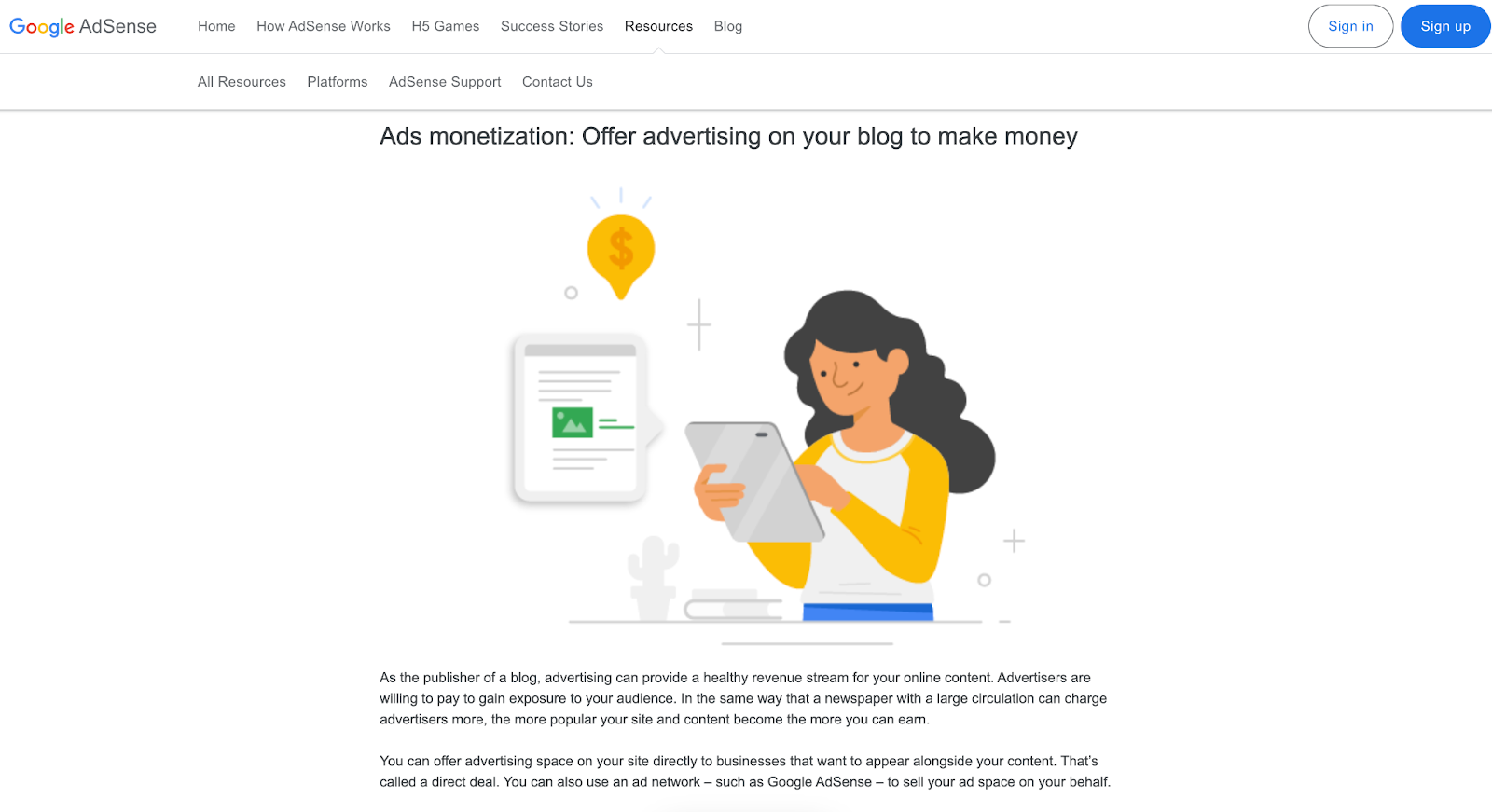
Google AdSense is widely regarded as the leading PPC advertising platform for bloggers. It’s renowned for its powerful algorithm, which serves highly relevant ads tailored to your blog's content and your visitors' browsing histories.
AdSense provides a range of ad formats, such as text, display, and video, and can be tailored to harmonize with your blog's design. The platform is user-friendly, allowing even beginners to easily set up and begin monetizing their blogs.
Best for: Bloggers across all niches, especially those with high traffic and diverse content. It’s particularly effective for general-interest blogs and those in niches with high advertiser demand.
RPM: Revenue on AdSense typically ranges from $0.20 to $2.50 per 1,000 views, but this can vary widely depending on many factors, including the content of the website, location of your target audience, and overall niche. The platform offers a tool that calculates your earnings according to the location and category of your website.
2. Media.net
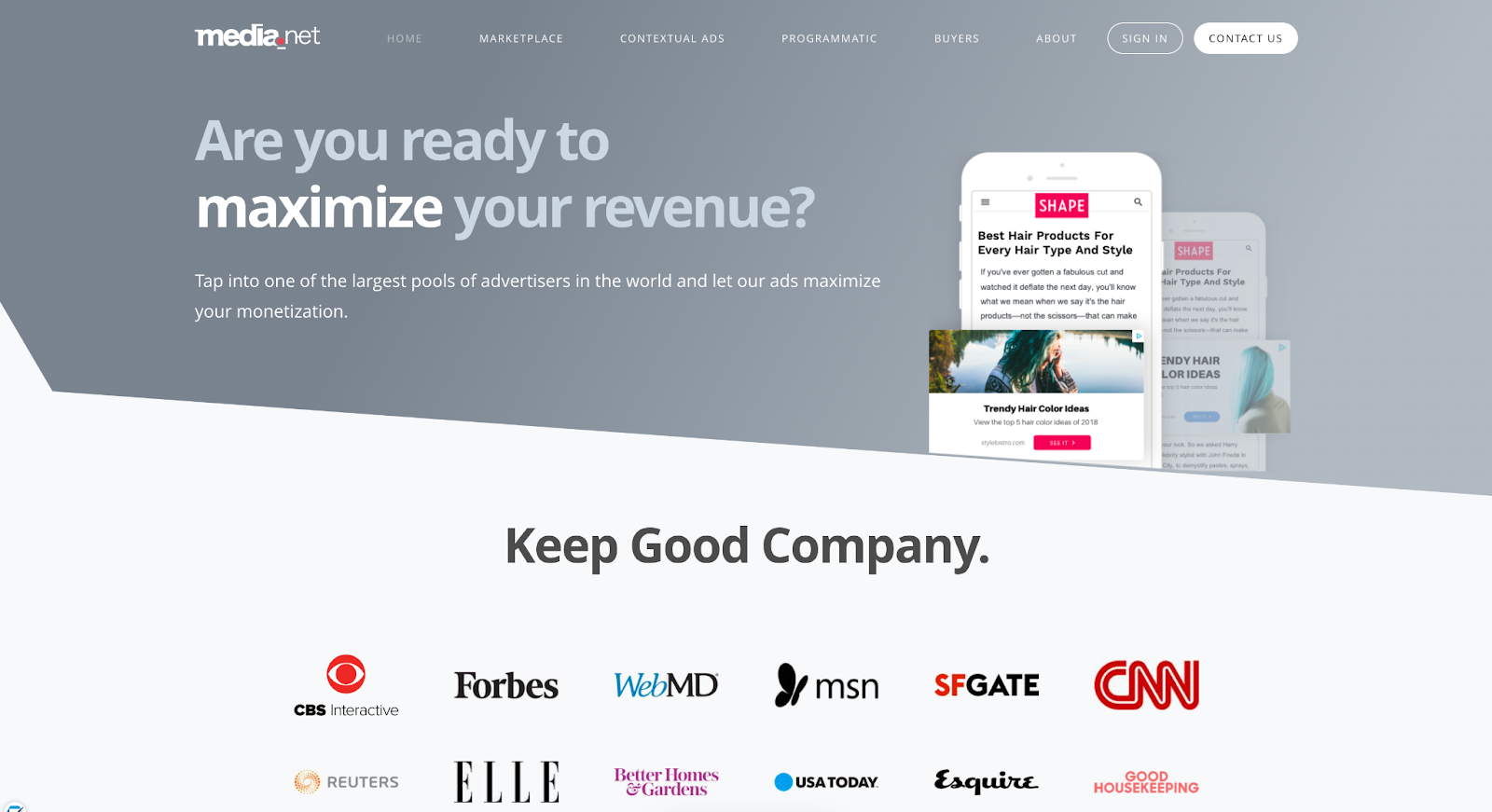
Powered by Yahoo and Bing, Media.net is a robust alternative to Google AdSense. It provides contextual ads tailored to your blog's content and is renowned for high-quality targeting that often leads to increased engagement rates. For blogs with substantial enough traffic, Media.net offers a dedicated account manager to optimize ad performance and boost earnings.
Best for: Mostly for bloggers seeking a robust alternative to AdSense, targeting niches where Yahoo and Bing have a strong presence, such as finance, education, and technology.
RPM: On average, publishers can earn between $0.20 and $5 for every 1,000 ad impressions. However, it's crucial to note that these figures are approximate, and actual earnings can vary significantly based on the specific website and audience.
3. Raptive (Formerly known as AdThrive)
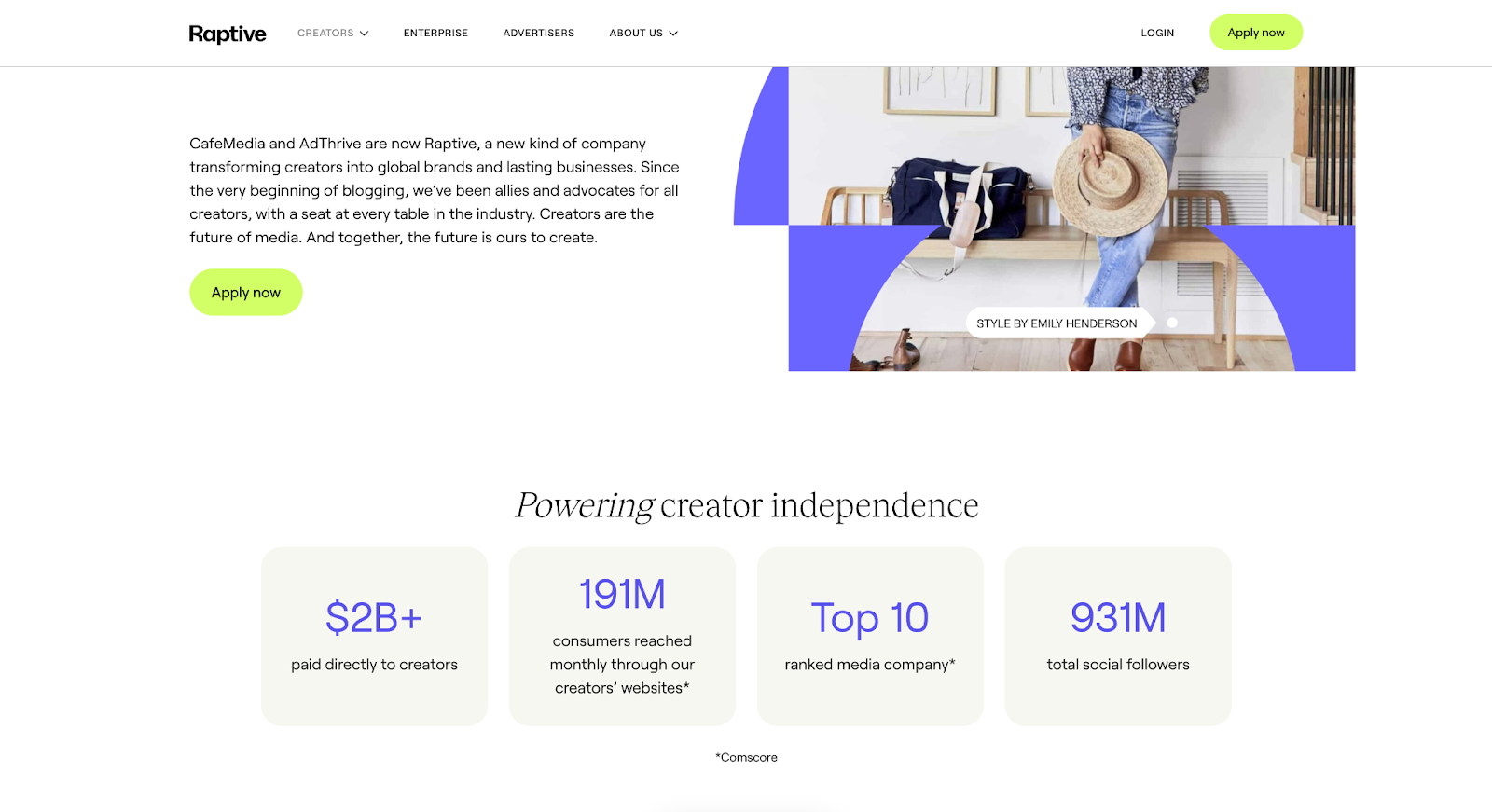
Raptive is a premium ad network ideal for established blogs that focuses on optimizing ad placements for maximum revenue. It offers personalized support, including site optimization, to ensure that ads perform their best. It's a site that works closely with bloggers to optimize content and ad layout, with the final goal of generating revenue boosts.
Best for: High-traffic blogs, especially in the lifestyle, food, and parenting niches. Since it works better with more established blogs, Raptive/AdThrive is known for delivering high RPMs compared to other platforms, making it a favorite among professional bloggers.
RPM: Estimates vary from $15 to $30 or more, depending on the niche and traffic quality. Highly competitive niches can result in earnings as high as $40.
4. Ezoic
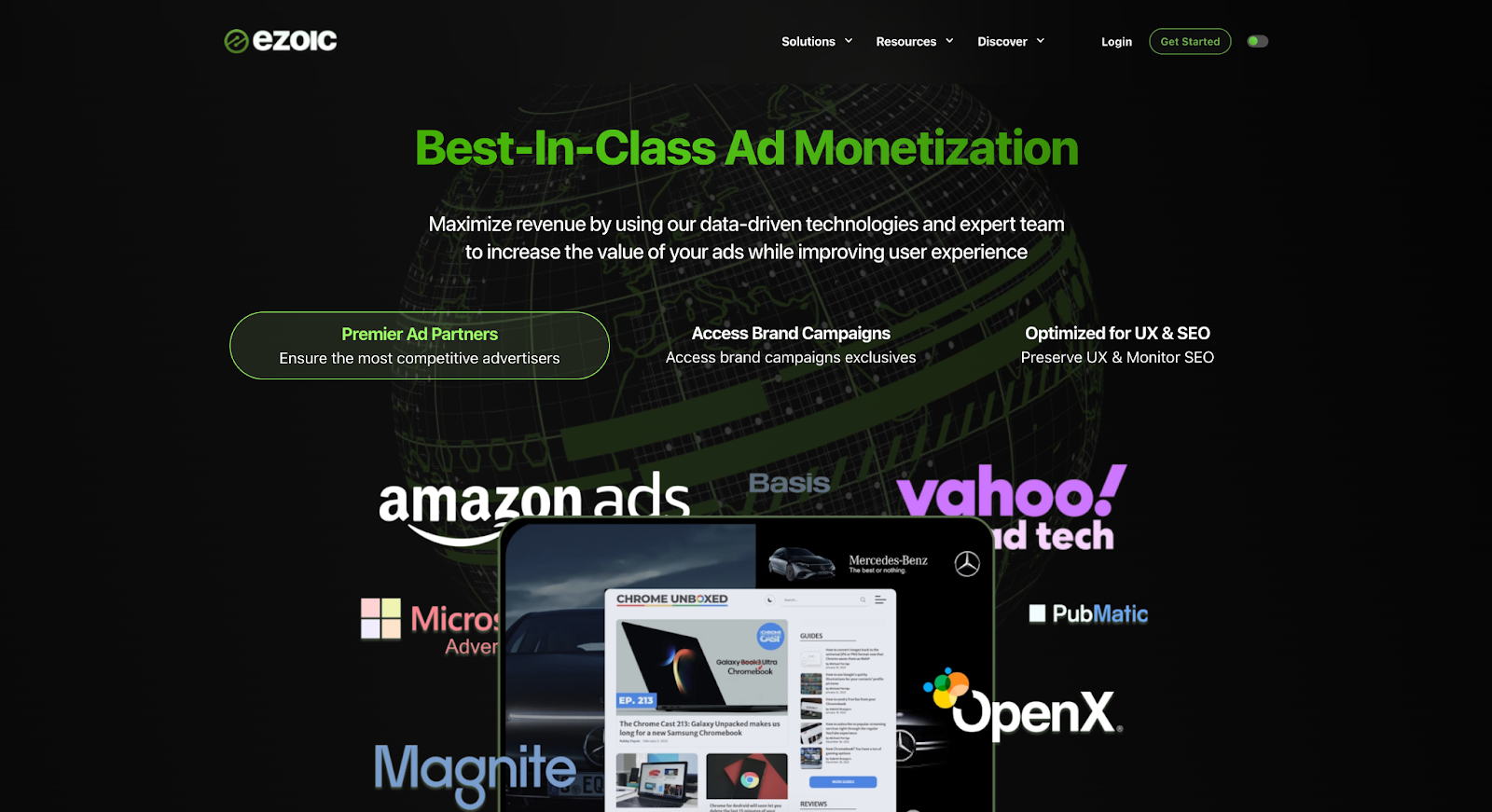
Ezoic is an AI-driven platform that offers a variety of ad formats and focuses on optimizing user experience alongside ad revenue. Ezoic’s technology automatically tests different ad placements and formats to find the combination that generates the most revenue without compromising user experience.
It's a great option for bloggers who want more control and insight into how ads are performing on their site.
Best for: Bloggers of all sizes who want to optimize their ad placements. Ezoic is a platform especially beneficial for those looking to balance ad revenue with user experience.
RPM: Typically ranges from $40 to $60, depending on the niche, region, and area you operate. Ezoic also offers a calculator to check the potential performance in terms of revenue per mille.
5. PropellerAds
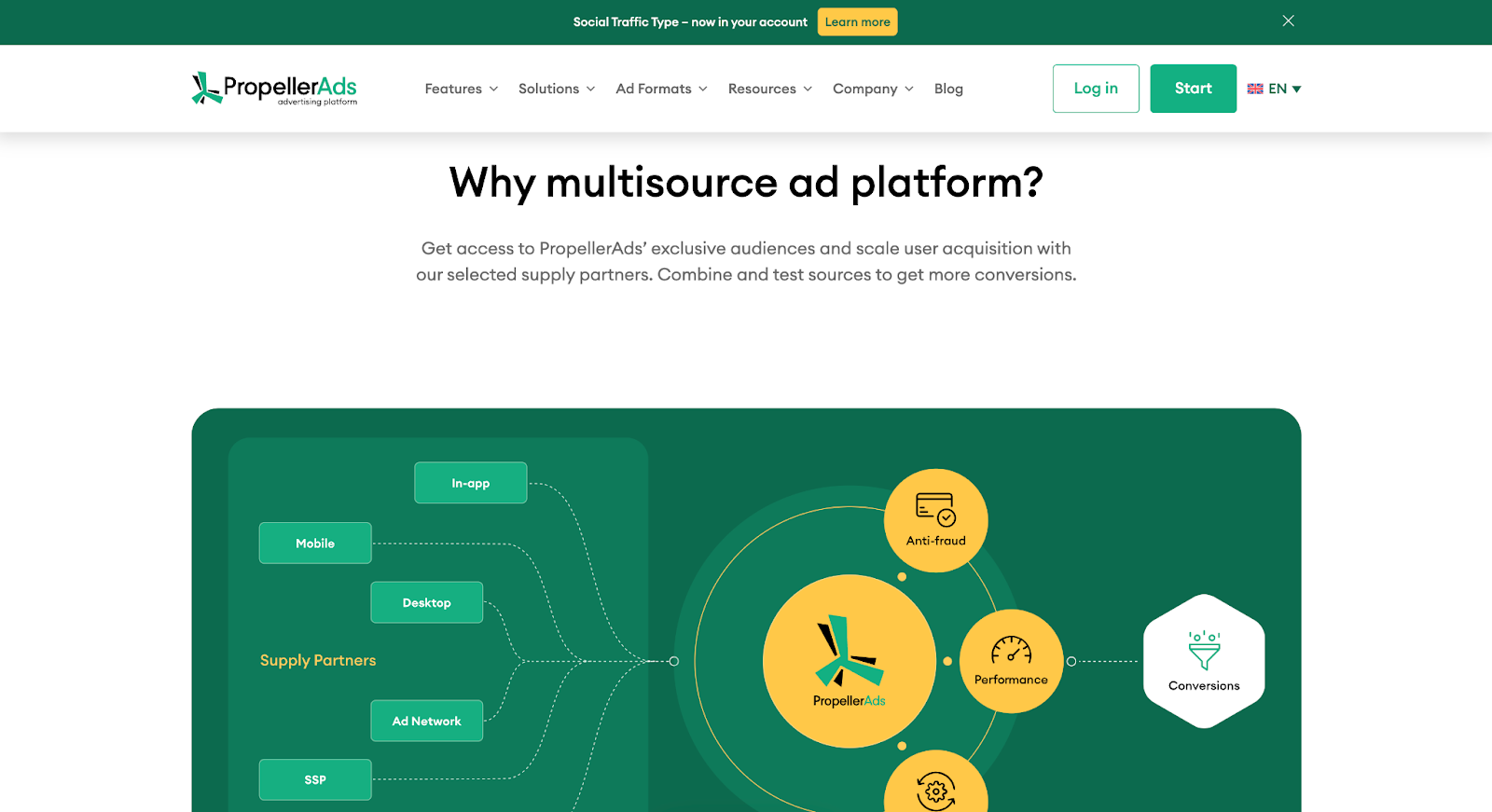
PropellerAds is a multisource advertising platform, with a massive global audience to reach new users and grow businesses. It specializes in high-impact ads like push notifications, interstitials, and native ads. It’s particularly known for its cost per mille (CPM) and is a nice fit for bloggers who want to explore non-traditional ad formats. PropellerAds also supports a wide range of verticals, making it versatile for different types of content.
Best for: Bloggers looking to monetize international traffic or those interested in using innovative ad formats, like push notifications, interstitials, and native ads.
RPM: The revenue per mille on PropellerAds is usually around $1 to $10, but can go higher depending on the ad format and audience location.
6. Infolinks
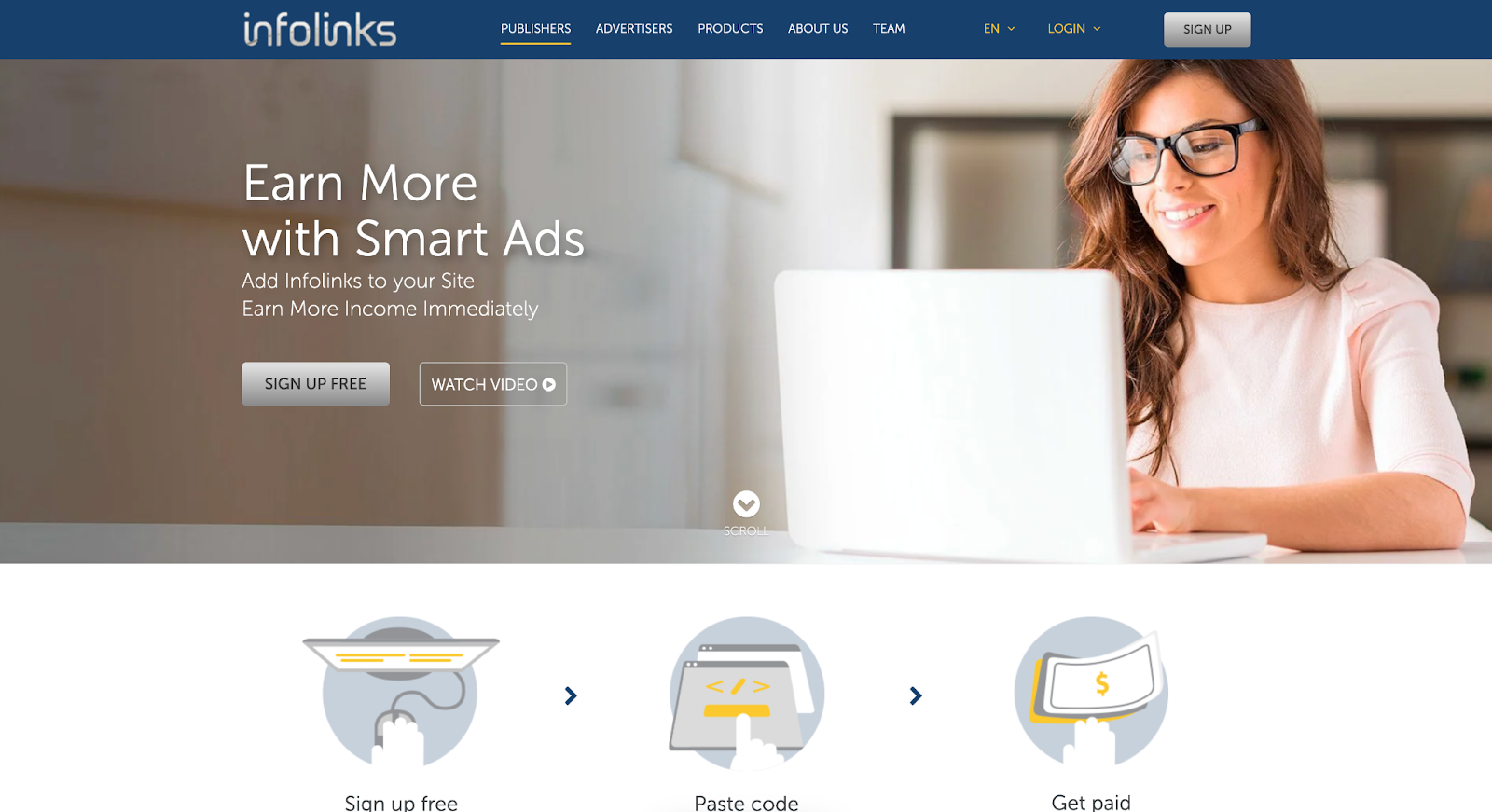
With 240 million monthly users, this is a platform that offers unique ad formats that don’t require standard banner placements. Instead, Infolinks provides in-text ads, overlay ads, and in-frame ads that blend seamlessly with your content. Infolinks is easy to integrate and is a great way to add additional revenue streams without cluttering a blog with traditional inside-the-box ads.
Best for: Bloggers who want to monetize their content without intrusive ad formats. It’s particularly effective for blogs with lots of text content where in-text ads can be naturally integrated.
RPM: Typically ranges from $2 to $10, depending on the traffic and content relevance.
7. SHE Media

SHE Media is an ad network with around 74 million monthly users, specifically tailored for female content creators. It offers a mix of display ads, sponsored content opportunities, and video ads. SHE Media also provides resources and community support for female bloggers, helping them grow their audiences and revenue.
Best for: As mentioned, it's made for female bloggers, especially those in the lifestyle, fashion, health, and parenting niches. It’s also ideal for bloggers who value community and support practices.
RPM: SHE Media offers strong support to users in increasing their RPM. This may be around $20 but can potentially increase with various practices and strategies that the platform itself offers.
8. Mediavine
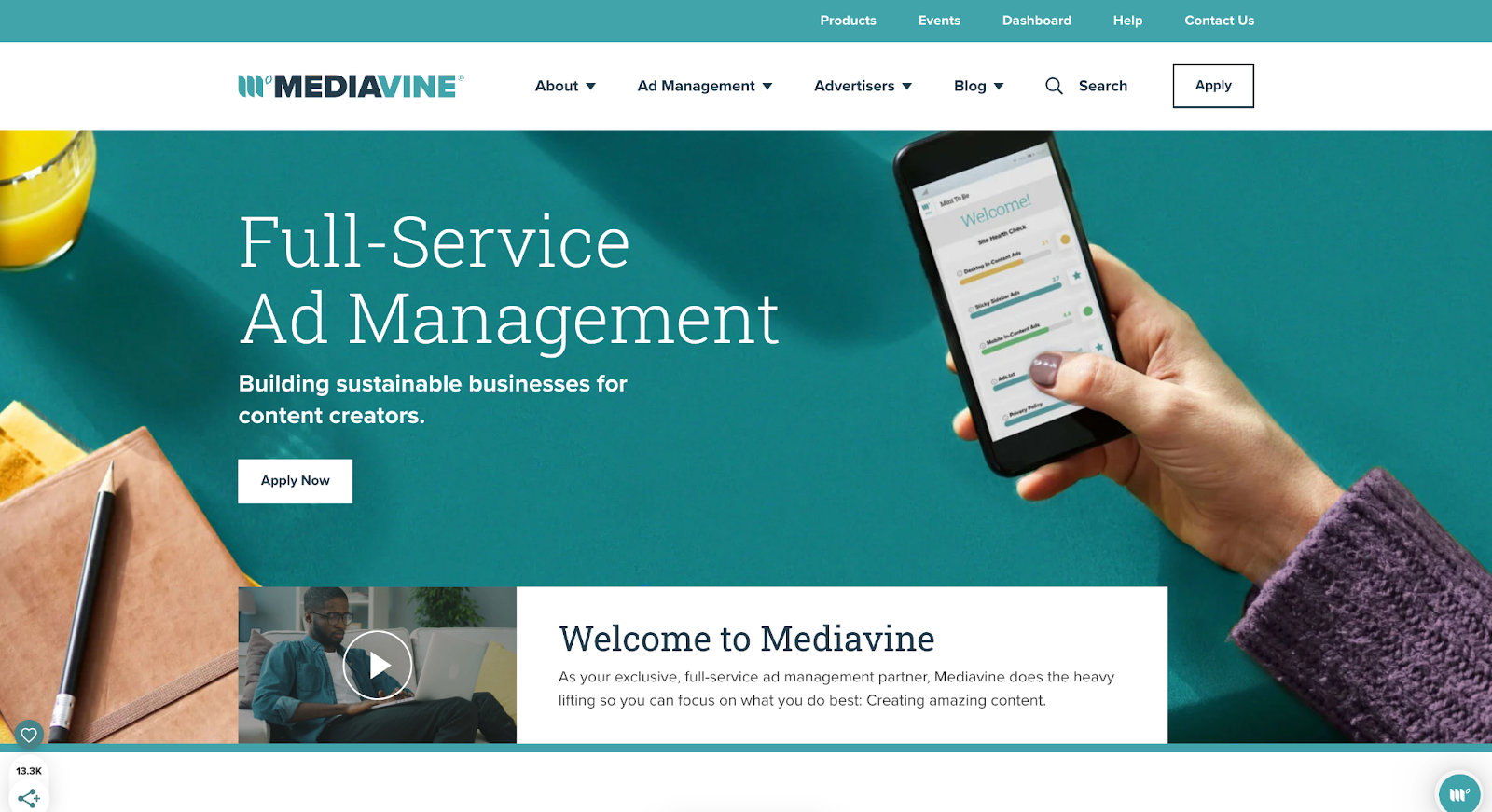
Another premium ad network that requires a minimum of 50,000 monthly sessions (per Google Analytics) to join. For this reason, it's known for its high RPMs and excellent customer service. Mediavine provides great ad management, including optimizing ad placements and load times, and ensures compliance with industry standards. It’s a great platform for a significant increase in ad revenue, but it takes a bit of effort to join.
Best for: Established bloggers who meet the traffic requirements of 50,000 monthly sessions—among other must-haves—and are looking for a high-quality ad network that offers hands-on support.
RPM: Around $20 to $30, with some niches seeing higher RPM.
9. Revcontent
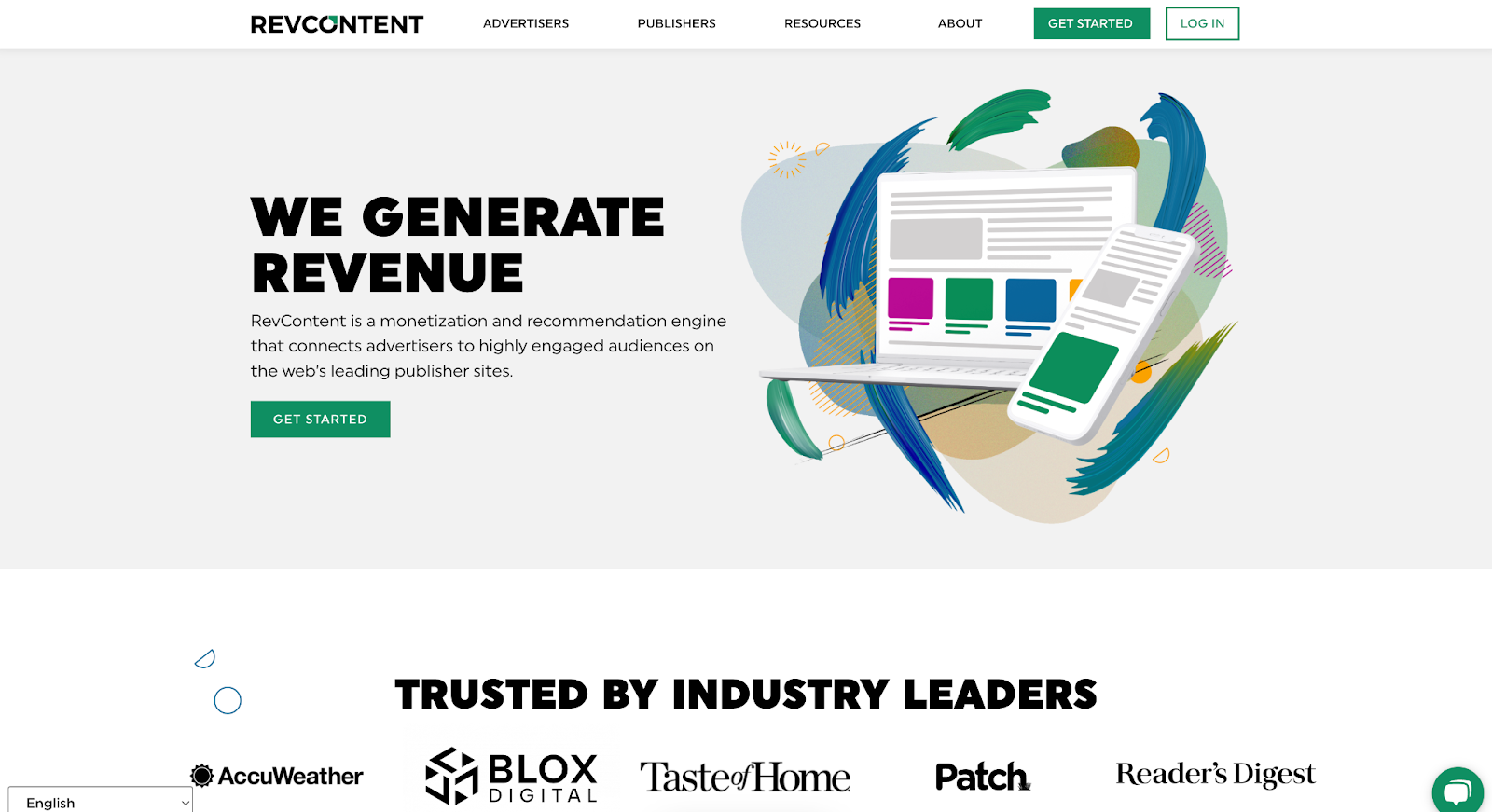
Revcontent is a content recommendation network known for its high-quality, native ads that blend in with the content on your site. Revcontent’s ads are less intrusive than traditional display ads, and they focus on delivering engaging, relevant content that resonates with your audience. This network is ideal for bloggers who prioritize user experience and want to avoid traditional banner ads.
Best for: Bloggers who want to monetize their site with native ads that enhance user engagement rather than detract from it. It’s particularly effective for blogs with a focus on story-heavy niches like news, entertainment, or lifestyle.
RPM: Ranges from $0.44 to $3, but, as usual, can vary widely based on audience, geographic location, and content being promoted.
What are the Alternatives to Pay-Per-Click?
Pay-per-click advertising is a popular way for bloggers to earn revenue, but it's not the only option. If you're looking to diversify your income, other performance-based models can be explored, like:
- Pay Per Sale (PPS): You earn a commission each time a customer makes a purchase through your referral link. This model is common in affiliate marketing, where you promote products or services and get paid a percentage of the sales generated.
- Pay Per Lead (PPL): Involves earning money each time you generate a qualified lead for a business. This could include filling out a form, signing up for a newsletter, or registering for a webinar. The focus is on driving specific actions rather than direct sales.
- Pay Per Install (PPI): You earn a commission whenever a user installs a software, app, or extension that you promote. This is common in the tech and gaming niches, with blogs or sites catering to tech-savvy audiences, especially those focused on software reviews, tech tutorials, or gaming.
- Pay Per View (PPV): Pays you for each view or impression of an ad, similar to CPM but often more focused on video or interactive ads. It’s ideal for sites that can host video ads or rich media content.
- Pay Per Download (PPD): You make money whenever a user downloads a file or software through your referral. This is common in niches where downloadable content is prevalent, such as eBooks, software, or media files. Selling digital products can be considered a PPD model.
- Pay Per Acquisition (PPA): This is similar to pay-per-sale but can also include other types of conversions, like sign-ups, form submissions, or subscriptions. The advertiser pays you when a specific action is completed.
- Revenue Sharing: In a revenue-sharing model, you partner with a company to share a percentage of the revenue generated from users you refer. This could be from ongoing subscriptions or continuous product purchases.
I should note that at their core, all of these are essentially the same. An advertiser (brand, service, company) is paying an affiliate (blog or site) a dollar amount for an action that the customer, or potential customer, makes. The affiliate has access to the traffic, and the advertiser wants that access.
Looking to Make Money With a Blog? Check Out Whop
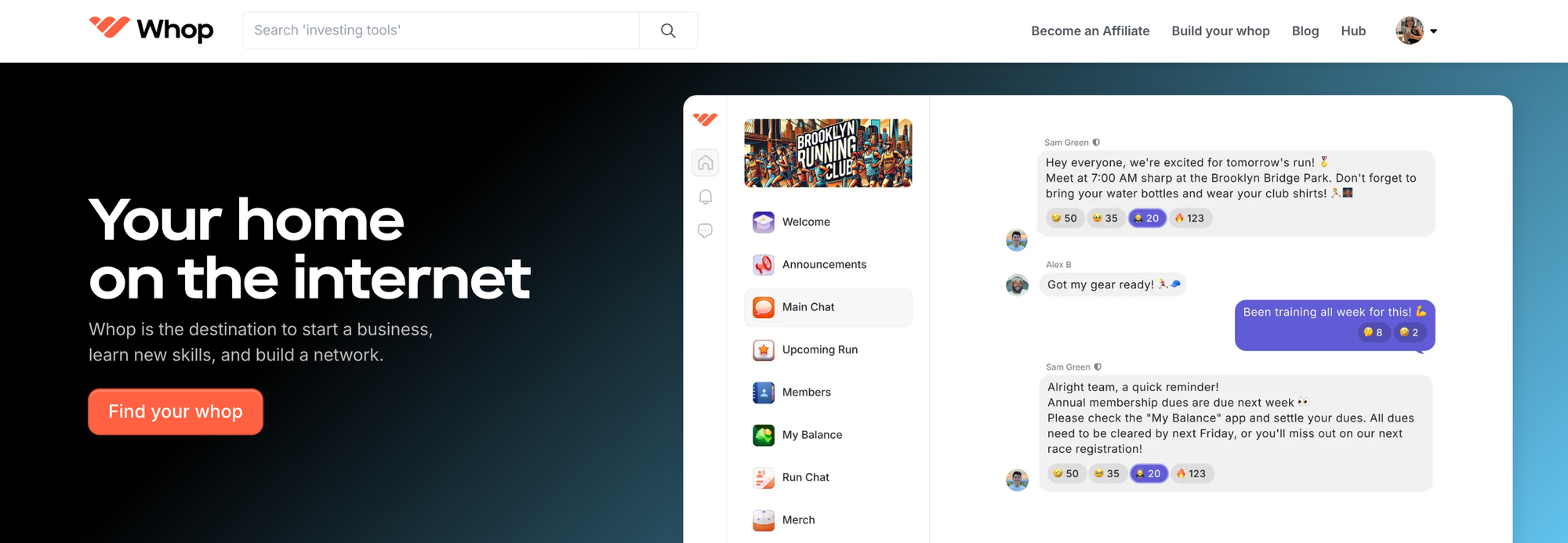
There's more than one way to monetize your blog. In addition to trying out PPC, why not directly monetize the content that you are writing?
There are so many ways to make money with your blog. You could sell access to premium paywalled content, or create a paid community. Plus as a writer, you can quickly turn your expertise into an online course, webinar, masterclass, or even an educational paid community using Whop (just as freelance writer Kaleigh Moore did). All you have to do is create a free whop hub on our platform, add the apps you wish to use, and begin charging access.
You don't have to choose just one money-making option. Use affiliate links in your blog, join a PPC ad platform, and teach others how to do it with a course and community.
The key to making money with your blog is to create multiple streams of income rather than relying on just one. So join Whop, diversify your revenue streams, and start making more money than you would just just ads alone.
Why You Should Trust Us
Joe Niehaus is a content writer and ecommerce expert at Whop. With an extensive background in ecommerce and affiliate marketing, he has also shared his knowledge with well-known publications like Travel + Leisure, GQ, and Business Insider.



